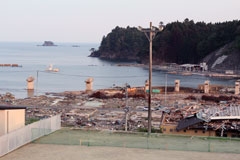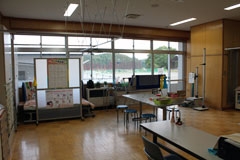Helping kids put disaster behind them
- Japan Diary by Francis Markus in Minamisanriku -
2011/07/29

I’m not really all that bothered by the fly buzzing around us as we chat in the school principal’s office, with cups of hot instant coffee standing in front of us.
But for the Deputy Principal of Isatomae Primary School, Toshiko Kanno, it’s definitely something out of the ordinary and a pointer to one key issue that’s on her mind. “We are very worried about the hygiene situation, because we still have no water and have to rely on bottled water” she says.
(Photo: Debris lie between the school and the ocean, and one can see it from the balcony of the second story Isatomae Primary School.)

Bottled Water Stockpiled
When she takes us on a tour of the school, we see there are piles of bottled water stacked up near the staircase and there’s also a water purifying system on hand in case that runs out.
“The whole town’s drinking water system is still not functional,” she says.
When we go out to the balcony on one of the upper storeys, we can see the destruction that lies between the school and the ocean, where the fury of the Tsunami flattened a shopping mall, homes and businesses.
(Photo: Ms. Toshiko Kanno, Deputy Principal of Isatomae Primary School)
It’s not just the students’ health situation that Mrs Kanno is worried about, she’s also concerned about their state of mind.

“Sometimes the kids look out to sea and they see big waves and they’re afraid there’s another Tsunami coming.”
The children have been receiving psychosocial support from a counsellor, to address some of the emotional fallout from the disaster.
(Photo: Isatomae School clinic was also once covered with mud, and all the teachers worked together to remove and brush off the mud by hand. )
And the Japanese Red Cross Society has agreed to provide equipment to improve the facilities in the school clinic, here and in nearly 60 other schools.

It’s just part of their efforts to make life safer and better for the younger generation affected by this disaster.
They are also planning to provide more computers youngsters in the schools in Fukushima Prefecture, where youngsters have been advised not to play outdoors because of the contamination from the nuclear plant.
But right here, we’re a long way from Fukushima. At this particular school, some of the children attending school don’t have far to go in the mornings, because they live in the temporary prefabricated housing which has been put up, using what used to be half the school’s playground.

Not All Prefabs Full
Still, not all the houses are full, because it’s proving hard to get all those people out of the evacuation centres who want to get out. Perhaps it’s easier for the children to get used to life in the centres than it is for the adults.
“I have several friends around my age, who I spend my time hanging out with,” says 15 year old Nozomi Murakami, a student whom we meet in one evacuation centre we stop by at on our travels.
(Photo: Nozomi enjoys hanging out with friends she met in the evacuation center.)
Her parents were allocated a prefabricated temporary house according to the lottery system that’s in operation. But they rejected the offer, because it was too far from her school. They’re currently waiting for a different allocation.
“My family doesn’t want to be the last to leave the evacuation centre.”
It’s almost time for dinner in the school gym which has become their temporary home and the volunteers and young people are helping to dish up large cauldrons of rice and portions of salad.
Another meal, another day nearly over and hopefully another small step towards normal life for the young generation and their parents.















